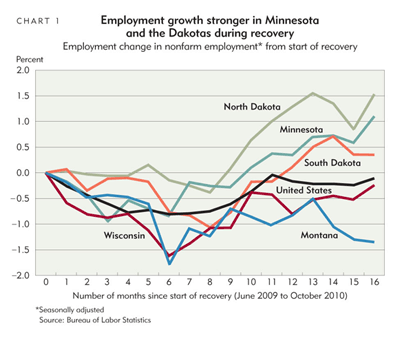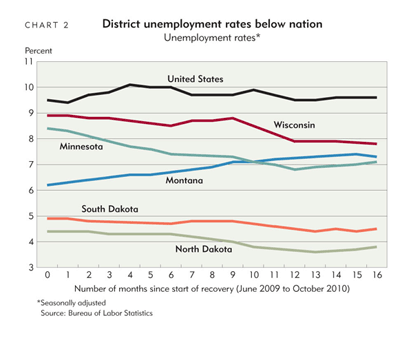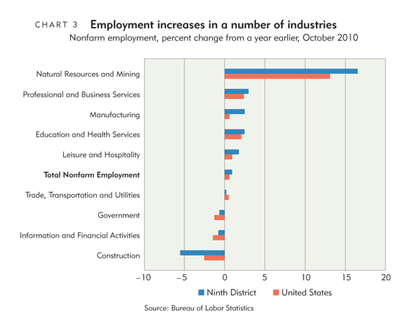The mild economic recovery could warm up in 2011, according to results from the Minneapolis Fed’s forecasting models and outlook surveys. Since the end of the recession in June 2009, economic conditions have slowly improved; and though employment levels dropped over this period, they have recently crept higher. Consumer spending has increased moderately, and the manufacturing sector is expanding.
Looking to 2011, respondents to the Minneapolis Fed’s business outlook poll have expressed renewed optimism following two years of pessimism. Furthermore, the forecasting models predict increases in income and employment. The agriculture outlook is upbeat, with ample soil moisture and expected higher prices for outputs. However, relatively high unemployment rates are predicted in some district states, and home building is not expected to recover anytime soon.
Underlying the overall positive report is optimism expressed by respondents to the business outlook poll, where 63 percent were somewhat or very optimistic for their community’s economy during 2011, up from 42 percent in last year’s poll (see “Businesses are optimistic for 2011”). This level of optimism hasn’t been recorded since the 2007 outlook poll. Respondents to the Minneapolis Fed’s survey on business confidence were also more positive than negative regarding business-related metrics involving their firm, including sales, profits, hiring and capital spending (see “One order of confidence, please”).
Overall employment is picking up
Since the beginning of the economic recovery in June 2009, U.S. and district employment growth has been subdued (see Chart 1). Nonfarm employment decreased in all district states except North Dakota, which was also the only district state where employment levels during the recession and recovery did not dip below prerecession levels.
However, during the second half of 2010, employment has begun to grow in district states, except in Montana, where employment levels have slid recently. But overall levels are comparatively low; Minnesota employment remains 3.6 percent below its prerecession level. Though district unemployment rates are better than the national rate across the board (see Chart 2), Minnesota, Montana and Wisconsin rates remain well above prerecession levels.
In October, district nonfarm employment was almost 1 percent ahead of last year, better than the 0.5 percent increase for the nation. Employment gains were led by natural resources and mining, which increased more than 16 percent (see Chart 3). North Dakota added 2,400 new jobs in this sector, as oil-drilling activity remains strong. In November, 139 oil rigs were active in North Dakota, up from 56 a year ago.
Other sectors with employment gains include professional and business services (3.1 percent), manufacturing (2.6 percent), education and health services (2.5 percent) and leisure and hospitality (1.6 percent). The construction sector posted the largest decrease (-5.3 percent), a steeper drop than national construction totals (-2.5 percent).
Montana’s recovery has been weaker than other areas of the district and the nation. The state posted an almost 1 percent decrease in nonfarm employment in October from a year earlier, in part because Montana’s construction sector shed a higher percentage of jobs than other district states, while sectors such as professional and business services, education and health services, and leisure and hospitality performed more poorly compared with other states.
The Minneapolis Fed’s forecasting model indicates that employment growth will pick up in 2011. Growth rates will exceed 2010 rates in all areas except Minnesota, where the pace of employment growth will remain the same. In many states, growth rates will meet or exceed averages over the previous 30 years.Respondents to the business outlook poll are optimistic about employment in 2011; 33 percent expect increases in full-time employees at their companies, while 9 percent expect decreases. Meanwhile, 37 percent of respondents to the survey of manufacturers anticipate increasing employment during 2011, while 9 percent expect decreases.
Another sign of labor market improvement is the decrease in initial claims for unemployment insurance benefits nationally and in the district. From October 2009 to October 2010, initial claims for unemployment benefits in district states decreased 22 percent; however, claims were still 34 percent more than October 2007, just before the recession began.
While labor markets are showing signs of strengthening, the Minneapolis Fed’s forecasting model predicts little change in unemployment rates in 2011. Even though employment is expected to pick up, so-called discouraged workers who dropped out of the labor force during the recession will likely begin looking for work again as job prospects improve. Workers returning to the labor force place upward pressure on unemployment rates because they get counted as unemployed instead of out of the labor force.
Consumer spending on the rise
Consumers are reaching into their pockets again after turning their backs during the recession.
Monthly U.S. retail sales through November increased on a year-over-year basis for more than 12 straight months after posting more than 12 straight months of decreases during the recession. A broader measure of consumer spending, personal consumption expenditures, has also grown for more than a year.
Within the district, signs pointed to a solid holiday spending season. According to the University of St. Thomas Holiday Spending Sentiment Survey, household spending for holiday gifts in the Minneapolis-St. Paul area was predicted to increase almost 7 percent this season from 2009. This is the survey’s first year since 2006 that holiday shoppers anticipated spending more rather than less.
Looking to 2011, the business outlook poll shows that 30 percent of respondents expect consumer spending to increase in their communities, while 19 percent anticipate decreases. These results are the most optimistic for consumer spending in six years. Manufacturers were also sanguine about consumer spending in their respective states, with 34 percent expecting increases in 2011 and 21 percent expecting decreases. The forecasting model shows that personal income growth is expected to pick up in 2011, which bodes well for consumer spending.
As consumers are spending more, overall price increases have remained subdued. The consumer price index increased 1.1 percent in November from a year ago. The CPI’s so-called core rate of inflation, which doesn’t include volatile food and energy prices, rose 0.8 percent in November from a year ago.Manufacturing making a comeback; home building still slow
During 2010, district manufacturing employment and activity expanded. A November survey of purchasing managers by Creighton University (Omaha, Neb.) showed that manufacturing activity has increased every month to date in 2010 in Minnesota and South Dakota, and for most of the year in North Dakota. Activity in the manufacturing sector received a boost from manufactured exports, which increased 18 percent in district states during the first 10 months of 2010 compared with the same period a year earlier.
Looking ahead, manufacturers are optimistic for the coming year. For 2011, 53 percent of respondents to the survey of manufacturers expect increases in production levels, while 9 percent expect decreases (see “Manufacturing activity up in 2010”). Of the manufacturers who responded to the business outlook poll, 45 percent plan to boost investments in plant and equipment, while 14 percent anticipate decreases.While the outlook for manufacturing is upbeat, home building remains slow. Nevertheless, after several years of decreases, 2010 will likely finish ahead of last year. During the first 10 months of 2010, housing units authorized in district states were up 10 percent compared with the same period a year ago. Even with this increase, district home building levels are down about 70 percent in 2010 from the height of the building boom during 2004.
Respondents to the business outlook poll were pessimistic for home building in 2011, with 40 percent expecting decreases in housing starts in their communities and 12 percent anticipating increases. In addition, the forecasting model points to lackluster performance in 2011.Agriculture hoping for decent 2011 after stellar year
“All segments of agriculture are again currently profitable,” commented a South Dakota agricultural lender in response to the third-quarter survey of credit conditions. Farmers were early into the fields and early out with this year’s harvest. Almost the whole Ninth District is free from drought, although excessively wet conditions, especially in South Dakota, hurt some producers. In addition to a bumper harvest, solid output prices aided the bottom line. Meat and dairy producers faced higher feed costs, but these costs were more than offset by higher output prices. There are optimistic expectations for newly purchased capital equipment, ample soil moisture and expected higher prices for outputs in 2011.
In 2010, both farmers and ranchers gained, but for different reasons. Farmers enjoyed a nearly ideal growing season, while ranchers benefited from significantly higher prices (see table). The district is expected to see overall production increases in soybeans (8 percent), wheat (4 percent) and sugar beets (14 percent) compared with 2009, while corn output is expected to fall slightly (2 percent). Meanwhile, ethanol prices and production trended upward during the second half of 2010. While prices for several farm inputs increased during 2010, including fertilizer, chemicals and diesel, these prices were more than offset by gains in crop prices and production.
While farmers had increases in production in 2010, ranchers enjoyed rising prices (see table below). Prices surged for hogs (33 percent), milk (27 percent) and steers (14 percent). The number of cattle on feed in South Dakota feedlots increased 12 percent in November 2010 from November 2009.
Again, the outlook for 2011 is upbeat, as agricultural producers invest their profits. “Capital spending will continue as farmers invest in their farming operations,” a South Dakota lender said. In addition to positive returns on investment, soil moisture conditions are good and output prices are expected to rise. According to U.S. Department of Agriculture forecasts, 2011 prices for corn, soybeans, wheat, steers and hogs are expected to increase. Meanwhile, sugar beet farmers face uncertainty regarding legal rulings on planting genetically modified seeds.
| Crop and meat prices expected to increase in 2011 Average farm prices |
||||
|---|---|---|---|---|
| 2007/ 2008 |
2008/ 2009 |
Estimated 2009/2010 | Projected 2010/2011 | |
| (Current $ per bushel) | ||||
| Corn |
4.20
|
4.06
|
3.55
|
4.80-5.60
|
| Soybean |
10.10
|
9.97
|
9.59
|
10.7-12.20
|
| Wheat |
6.48
|
6.78
|
4.87
|
5.30-5.70
|
2008 |
2009 |
Estimated 2010
|
Projected
2011 |
|
| (Current $ per cwt) | ||||
| All Milk |
18.29
|
12.83
|
16.25-16.35
|
15.90-16.70
|
| Choice Steers |
92.27
|
83.25
|
95.19
|
96.00-104.00
|
| Barrows & Gilts |
47.84
|
41.24
|
54.91
|
53.00-57.00
|
|
Source: |
||||









